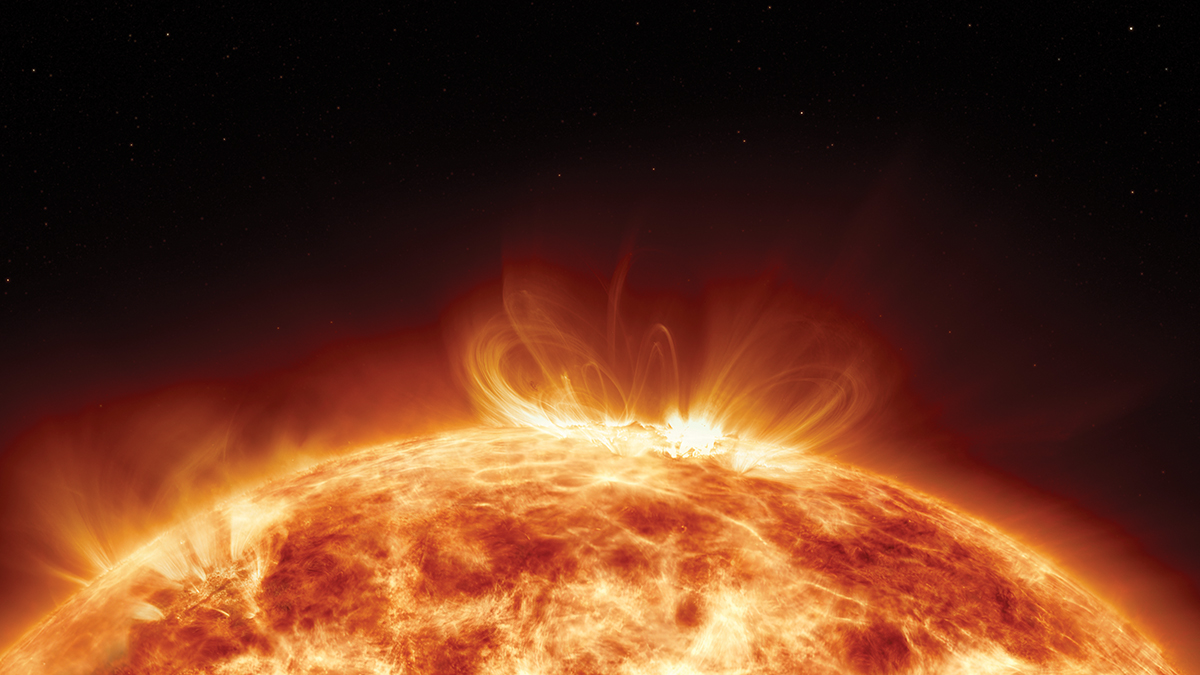Solar storms have fascinated and challenged humanity for centuries. These awe-inspiring phenomena, such as the aurora borealis, are caused by solar flares—intense bursts of energy from the Sun. But beyond their beauty lies a stark reality: severe solar storms can disrupt telecommunications, satellites, and power grids, creating far-reaching consequences for global society.
What Causes Solar Storms?
Solar flares eject high-energy particles into space, which, upon reaching Earth, interact with its atmosphere to create auroras. According to physicist Dr Kęstutis Ikamas, “Solar flares occur regularly, but during the solar maximum, which peaks every 11 years, their intensity increases.”
Scientists predict the current solar cycle’s peak activity to persist through 2025. The implications of such storms can be far-reaching.
While the breathtaking northern lights are one of the more benign outcomes of solar flares, more powerful storms can have catastrophic effects. For instance, a particularly intense solar storm in 2022 caused widespread satellite failures, including the loss of 40 SpaceX satellites, resulting in losses of up to $100 million. The most powerful recorded storm, the 1859 Carrington Event, caused widespread disruptions to telegraph systems. If a similar event occurred today, the global consequences could be much more severe.
A Crisis in the Making
Modern infrastructure, heavily reliant on electricity and telecommunications, is especially vulnerable. “A strong geomagnetic storm could incapacitate vital systems such as electricity, water supply, and telecommunications, leading to extended blackouts, communication breakdowns, and logistical paralysis,” warns Dr Ikamas. “While most people might experience minor disruptions to personal devices, the real impact would stem from large-scale failures in infrastructure. A large-scale geomagnetic storm could disrupt electricity grids for months, potentially triggering a humanitarian crisis in affected regions”
For example, without power, fuel stations would be unable to operate, and heating systems would fail, particularly in colder climates. Water systems, which depend on electricity to function, could also collapse, exacerbating the crisis. The situation could mirror the difficulties faced in conflict zones, where infrastructure has been intentionally targeted or destroyed.
Vulnerability and Preparation: A Global Challenge
The interconnected nature of modern infrastructure means that a powerful geomagnetic storm could disrupt multiple systems simultaneously. According to Dr. Ikamas, countries with extensive power grids—like the US, Canada, and Russia—are particularly vulnerable due to the length of their transmission lines. “Larger countries are at greater risk because their electrical grids are more susceptible to geomagnetic disturbances,” he says. In contrast, nations with shorter grids might face less severe disruptions.
However, regardless of location, preparing for such an event remains a significant challenge. Dr. Ikamas points out that solar storms often give only hours to days of warning before striking. “Governments and corporations need detailed, actionable plans to mitigate potential damage,” he adds. But even with adequate preparation, many critical systems can’t be quickly shut down without causing further complications. “The complexity of power plants and communication networks means that any sudden shutdown could trigger cascading failures,” notes the researcher.
Although there are some protective measures in place for satellites and power grids, Dr. Ikamas warns that these are not enough to withstand extreme geomagnetic storms. “The cost of enhancing these defenses is high, and investment is limited, despite the massive potential costs of inaction,” he says.
Broader Implications
Solar storms have far-reaching effects beyond power outages. They can disrupt GPS systems, mobile networks, and internet services, which could paralyze global communications and commerce. “A particularly strong storm could temporarily disable navigation systems vital for aviation, maritime shipping, and military operations,” explains Dr. Ikamas.
In addition to impacting technology, geomagnetic storms may also disrupt animal migration patterns. Birds and marine animals, which rely on Earth’s magnetic field, could be confused by sudden changes, affecting their navigation. Even astronauts are at risk. “Astronauts in space are particularly vulnerable to radiation because they’re not protected by Earth’s magnetic field,” says Dr. Ikamas.
While severe solar storms are rare, preparation is critical. “If a strong storm is reported, individuals should disconnect their devices from power sources to prevent damage,” Dr. Ikamas advises. But safeguarding critical infrastructure requires more than individual action. “International cooperation and substantial investment are necessary to protect against the far-reaching effects of a solar superstorm,” he stresses.
Experts agree that further investment is essential to protect against extreme solar storms. Though statistically infrequent, the potential consequences are far too significant to overlook. Dr. Ikamas notes, “The economic damage from a severe geomagnetic storm could reach trillions of dollars, affecting everything from global commerce to daily life.”
The Path Forward
In the face of such risks, experts emphasize the need for global collaboration. Dr. Ikamas concludes, “While solar storms remain low-probability events, their potential impact is too great to ignore. We must prioritize strengthening our infrastructure to withstand these disruptive forces of nature.” Preparing for a solar superstorm requires not only scientific understanding but also significant resources and strategic planning to protect our increasingly technology-dependent world.
Geomagnetic Storm Impact Scale
G1 Minor. Weak power grid fluctuations and minor impacts on satellites are possible. The aurora is commonly visible at high latitudes.
G2 Moderate. Transformer damage is possible with long-duration storms. Corrective actions to spacecraft orientation may be required, which may affect orbit predictions. The aurora can be seen in northern Scandinavia.
G3 Strong. Power system voltage corrections may be required. Satellite navigation problems may occur. Radio and telecommunications may be affected. The aurora can be seen throughout Scandinavia and, potentially, in Lithuania.
G4 Severe. Possible widespread voltage control issues on the power grid. Sporadic high-frequency radio blackouts, satellite navigation disrupted for several hours, and low-frequency radio navigation issues. The aurora can be seen in parts of Europe.
G5 Extreme. Blackouts or complete collapse of power grids are possible. Navigation systems may be out for hours or days. The aurora can be seen almost everywhere in Europe.











Find Us on Socials